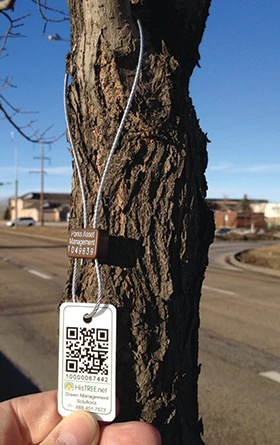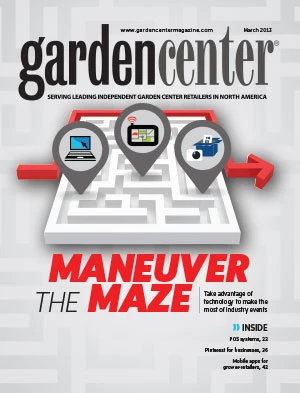
 The same technology that helps you find the nearest coffee shop may be the next big thing in nursery inventory management. Global positioning systems (GPS) and global information systems (GIS) provide the technology behind traceability — the ability to track a tree’s location from its infancy at the nursery to its eventual planting in a landscape.
The same technology that helps you find the nearest coffee shop may be the next big thing in nursery inventory management. Global positioning systems (GPS) and global information systems (GIS) provide the technology behind traceability — the ability to track a tree’s location from its infancy at the nursery to its eventual planting in a landscape.
It’s not as far-fetched as you might think. Some municipalities are starting to mandate that nurseries provide a detailed tree history before making a purchase.
In Canada, there is a strong push for nursery certification to ensure certain standards are being met, much like ISO certification for manufacturers. In 2006, the Canadian Nursery and Landscape Association began developing a certification system. The Canadian Nursery Certification Program (CNCP) and “Clean Plants” certifications are designed to provide a standardized system to ensure quality and the health of plant materials for shipment throughout Canada, and for export and import to the U.S.
To become “Clean Plants” or CNCP certified in Canada, nurseries must be able to provide the seed source of each tree grown, as well as the best management practices that have occurred during the tree’s lifetime.
Wave of the future
Stewart Brothers Nurseries, a shade tree grower in Kelowna, British Columbia, was looking for an inventory management system with tree tracking functionality to achieve certification for Clean Plants.
To get there, the nursery used a service called HisTREE, a tree management system that handles inventory management, records maintenance and inspection information and analyzes tree data and trends.
“You will know exactly where a seed of a tree came from and can keep track of its movement within the nursery until it is shipped to the customer,” said Kal Jhaj, sales manager with Stewart Brothers Nurseries. “It’s also handy for inventory control, so you’ll know how many trees will be available next year or the year after. It helps you keep track of each variety and what state they are in. When it goes to the job site, the customer will know exactly where a tree came from. If something happens down the road, he can backtrack.”
Under HisTREE, each tree is identified as an individual asset using either QR or RFID scanning technology, and the entire history of that tree is accessible by scanning that tree’s tag. Customers such as contractors or municipalities that purchase the HisTREE service can query the database to track down trees of a particular type or from a particular nursery. Within minutes, they will have a list of those trees and their location on a map.
 Nursery staff can scan the QR or RFID tag on trees in the field to see the last time they were watered, pruned or inspected for pests.
Nursery staff can scan the QR or RFID tag on trees in the field to see the last time they were watered, pruned or inspected for pests.
“Anytime you do anything with a tree, you can record it,” Jhaj said.
Nurseries do these inspections, but they are usually recorded on paper. HisTREE’s aim is to give nurseries the ability to record data on a smartphone interface, using cloud computing to integrate their inventory into an industry-wide database.
“It’s the next generation of data management,” said Art Maat, founder and president of HisTREE. “We developed our product in response to the certification process, to be able to provide nurseries and municipalities with traceability on an individual tree basis. It’s just starting to grab hold now.”
Pinpoint location
J.P. Jackson, founder of Appalachian Native Plants in Mountain City, Tenn., uses GPS technology to find the best native plants to propagate. ANP, a non-profit corporation working with Appalachian State University, the University of Tennessee and Johnson County, Tenn., grows native ornamentals such as azalea, rhododendron and hydrangea.
In mid-June, Jackson hikes into the Blue Ridge Mountains looking for the best-blooming native azaleas. When he finds one he likes, he records the coordinates with a handheld GPS system so he can return in the fall to check the foliage on that exact plant. GPS tracking helps him save time on the return visit - as well as helping ensure the particular plant will still be there.
“It’s way better than marking a plant where somebody else can tell that it’s special, because they tend to disappear,” Jackson said. “Somebody will dig it up or collect all the seed before you can get back to it.”
Jackson’s handheld GPS system includes topographical maps, which help him pinpoint the plant’s location.
“If you take photos of surrounding landmarks, or make a notation that indicates the characteristics of the plant, you have a fair amount of data about that plant,” Jackson said.
ANP’s motto is “Plant preservation through propagation and production,” and GPS helps the nursery achieve it.
Gaining steam
One of the major reasons traceability has traction is its potential pest and disease implications. Maat said if traceability became industry-standard, it could curb the spread of the invasive pests like the emerald ash borer.
 “Had all those trees been tagged and identified with their location, you could easily identify every ash tree in your county or state, visit and assess them, you could trend the EAB’s path across the state,” Maat said. “You could isolate it, even do fire breaks.”
“Had all those trees been tagged and identified with their location, you could easily identify every ash tree in your county or state, visit and assess them, you could trend the EAB’s path across the state,” Maat said. “You could isolate it, even do fire breaks.”
Stewart Brothers uses HisTREE to record pesticide applications in the field and to schedule future applications.
“You’ll know exactly when you sprayed, what you sprayed for, and what chemical you used,” Jhaj said.
Another reason traceability is gaining steam is that it is no longer cost-prohibitive. Stewart Brothers started using RFID tags, but the nursery prefers tags using QR codes — two-dimensional barcodes that hold more information than traditional one-dimensional barcodes in a smaller space.
“We’ve gone from a $3,000 scanning device in the RFID world, to scanning on a smartphone that people already own,” Maat said. “And it has the ability to perform database and traceability management from an iPhone with QR functionality.”
The MyHisTREE app is available for iPhone, iPad and iPod Touch in Apple’s App Store. Android and BlackBerry versions of the app are in the works.

Explore the March 2013 Issue
Check out more from this issue and find your next story to read.
Latest from Garden Center
- [WATCH] Looking Back to Spring Ahead: Where we’ve been & where the industry is headed in 2026
- Seed Your Future plans to bring 80+ students to MANTS 2026
- Donna McGinnis named next CEO of Denver Botanic Gardens
- HRI Leadership Academy opens applications for 2027 class
- Sustainabloom introduces Sustainability Planning Template for Retail Florists
- Burpee releases commemorative seed collection to celebrate America's 250th anniversary
- New Michigan box tree moth alert available in English and Spanish
- Seed Your Future announces board updates, 2025 Cross-Curricular Career Lessons





